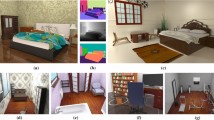Abstract
Building photorealistic 3D models of real-world objects is a fundamental problem in computer vision and computer graphics. Such models require precise geometry as well as detailed texture on the surface. Textures allow one to obtain visual effects that are essential for high-quality rendering. Photorealism is further enhanced by adding surface roughness in form of the so-called 3D texture represented by a bump map.
Access this chapter
Tax calculation will be finalised at checkout
Purchases are for personal use only
Preview
Unable to display preview. Download preview PDF.
Similar content being viewed by others
References
P.J. Besl and N.D. McKay. A Method for Registration of 3-D Shapes. IEEE Trans. Pattern Analysis and Machine Intelligence, 14:239–256, 1992.
K. Brunnström and A.J. Stoddart. Genetic algorithms for free-form surface matching. In Proc. International Conference on Pattern Recognition, volume 4, pages 689–693. IEEE Comp. Soc., 1996.
P.J. Burt and E. H. Adelson. A multiresolution spline with application to image mosaics. ACM Trans. Graph.., 2(4):217–236, 1983.
D. Chetverikov, D. Stepanov, and P. Krsek. Robust Euclidean Alignment of 3D point sets: the Trimmed Iterative Closest Point algorithm. Image and Vision Computing, 23:299–309, 2005.
C.K. Chow, H.T. Tsui, and T. Lee. Surface registration using a dynamic genetic algorithm. Pattern Recognition, 37:105–117, 2004.
O. Cordon, S. Damas, and J. Santamaria. A CHC Evolutionary Algorithm for 3D Image Registration. In LNAI, volume 2715, pages 404–411. Springer, 2003.
T. Csendes. Nonlinear parameter estimation by global optimization – Efficiency and Reliability. Acta Cybernetica, 8:361–370, 1988.
F. Bernardini et al. Building a digital model of Michelangelo’s Florentine Pietà. IEEE Comp. Graphics & Applications, 22(1):59–67, 2002.
K. Ikeuchi et al. The great Buddha project: Modeling cultural heritage for VR systems through observation. In Proc. IEEE ISMAR03, 2003.
M.J. Clarkson et al. Using photo-consistency to register 2D optical images of the human face to a 3D surface model. IEEE Tr. on PAMI, 23:1266–1280, 2001.
P. David et al. SoftPOSIT: Simultaneous pose and correspondence determination. In Proc. 7 th European Conf. on Computer Vision, pages 698–714, 2002.
R.B. Haralick et al. Pose estimation from corresponding point data. IEEE Tr. on SMC, 19:1426–1445, 1989.
M.S. Floater and K. Hormann. Surface parameterization: a tutorial and survey. In N. A. Dodgson, M. S. Floater, and M. A. Sabin, editors, Advances in Multiresolution for Geometric Modelling, Mathematics and Visualization, pages 157–186. Springer-Verlag, Berlin, Heidelberg, 2005.
R. Hartley and A. Zisserman. Multiple View Geometry in Computer Vision. Cambridge Univ. Press, 2000.
J.J. Jacq and C. Roux. Registration of 3-D images by genetic optimization. Pattern Recognition Letters, 16:823–841, 1995.
Z. Jankó and D. Chetverikov. Photo-consistency based registration of an uncalibrated image pair to a 3D surface model using genetic algorithm. In Proc. 2 nd Int. Symp. on 3D Data Processing, Visualization & Transmission, pages 616–622, 2004.
Z. Jankó, D. Chetverikov, and A. Ekárt. Using a genetic algorithm to register an uncalibrated image pair to a 3D surface model. Int. Sci. Journal of Engineering Applications of Artificial Intelligence, 2005. Accepted for publication.
G. Kós. An algorithm to triangulate surfaces in 3D using unorganised point clouds. Computing Suppl.., 14:219–232, 2001.
G. Kós and T. Várady. Parameterizing complex triangular meshes. In Proc. 5 th International Conf. on Curves and Surfaces, pages 265–274, 2003.
K.N. Kutulakos and S.M. Seitz. A Theory of Shape by Space Carving. Prentice Hall, 1993.
M.E. Leventon, W.M. Wells III, and W.E.L. Grimson. Multiple view 2D-3D mutual information registration. In Proc. Image Understanding Workshop, 1997.
E. Lomonosov, D. Chetverikov, and A. Ekárt. Pre-registration of arbitrarily oriented 3D surfaces using a genetic algorithm. Pattern Recognition Letters, Special Issue on Evolutionary Computer Vision and Image Understanding, 2005. Accepted for publication.
M. Levoy et al. The digital Michelangelo project. ACM Computer Graphics Proceedings, pages 131–144, 2000.
Z. Michalewicz and D. B. Fogel. How to Solve It: Modern Heuristics. Springer, 2000.
G. Renner and A. Ekárt. Genetic algorithms in computer aided design. Computer-Aided Design, pages 709–726, 2003.
C. Robertson and R. Fisher. Parallel evolutionary registration of range data. Computer Vision and Image Understanding, 87:39–55, 2002.
M. Salomon, G.R. Perrin, and F. Heitz. Differential Evolution for Medical Image Registration. In International Conference on Artificial Intelligence, pages 201–207, 2001.
L. Silva, O.R.P. Bellon, and K.L. Boyer. Enhanced, robust genetic algorithms for multiview range image registration. In Fourth International Conference on 3-D Digital Imaging and Modeling, pages 268–275, 2003.
S.M. Yamany, M.N. Ahmed, and A.A. Farag. A New Genetic-Based Technique for Matching 3D Curves and Surfaces. Pattern Recognition, 32:1817–1820, 1999.
Y. Yemez and F. Schmitt. 3D reconstruction of real objects with high resolution shape and texture. Image and Vision Computing, 22:1137–1153, 2004.
Author information
Authors and Affiliations
Editor information
Editors and Affiliations
Rights and permissions
Copyright information
© 2007 Springer
About this chapter
Cite this chapter
Chetverikov, D., Jankó, Z., Lomonosov, E., Ekárt, A. (2007). Creating Photorealistic Models by Data Fusion with Genetic Algorithms. In: Nachtegael, M., Van der Weken, D., Kerre, E.E., Philips, W. (eds) Soft Computing in Image Processing. Studies in Fuzziness and Soft Computing, vol 210. Springer, Berlin, Heidelberg. https://doi.org/10.1007/978-3-540-38233-1_9
Download citation
DOI: https://doi.org/10.1007/978-3-540-38233-1_9
Publisher Name: Springer, Berlin, Heidelberg
Print ISBN: 978-3-540-38232-4
Online ISBN: 978-3-540-38233-1
eBook Packages: EngineeringEngineering (R0)




